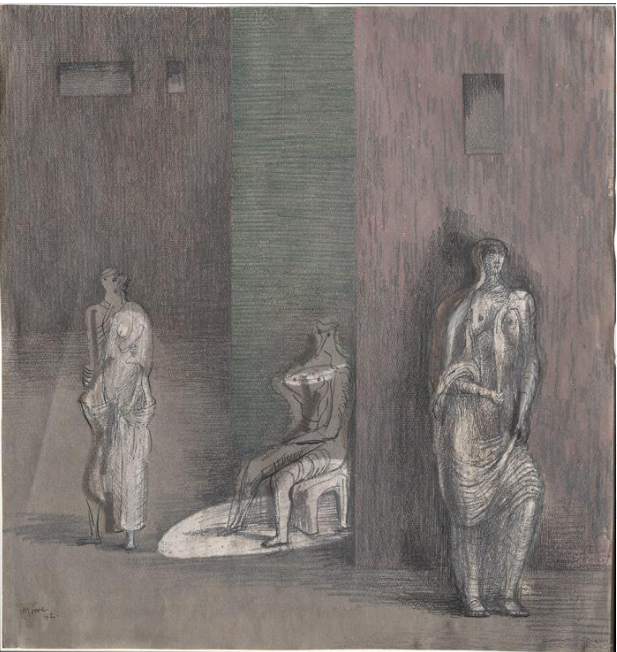Henry Moore (1898-1986), Three Figures in a Setting (1942)
Henry Moore was primarily a sculptor, and has said that his sketches were meant to be “a help towards making sculpture…as a way of sorting out ideas and developing them.” More often than not, he depicted fragmented, abstract interpretations of the female body. He also likened the female body to natural objects in his work, such as pebbles and shells, and thus powerfully represented both the human body and the natural world at once. In this piece in particular, it seems as though spotlights are shining down on the women, turning them into spectacles meant to be looked at; this brings into question the modernist debate over whether or not the female body is meant to be the object of the male gaze, and what that means for the role of women going forward.
Jazz as a genre of music is based on rhythmic urgency and improvisation — it is multifaceted, fluid, and imperfect. This mirrors Moore’s fragmented portrayal of the female form, especially in this sketch.
“Her figure was slight and graceful, inclining even to fragility but those iron jelloids she had been taking of late had done her a world of good much better than the Widow Welch’s female pills and she was much better of those discharges she used to get and that tired feeling. The waxen pallor of her face was almost spiritual in its ivorylike purity though her rosebud mouth was a genuine Cupid’s bow, Greekly perfect. Her hands were of finely veined alabaster with tapering fingers and as white as lemonjuice and queen of ointments could make them though it was not true that she used to wear kid gloves in bed or take a milk footbath either.”
– Excerpt from “Nausicaa” from Ulysses by James Joyce. Here, as in Moore’s work, we see the fragmentation of the female body — not a polished or censored one, but straightforward and imperfect, even if in Joyce’s case this means the inclusion of that which may be considered to be more private details. We also see the introduction of consumerism as a means by which women may alter their appearances. The main question raised in “Nausicaa” is that of whether or not women can use their appearances as a form of power and influence over men, as objects of the male gaze.
Excerpts from interviews with Henry Moore, BBC Archives
Categories: Nature, Spectacle, Surrealism, The Body, The New Woman, Urbanism and Industrialism



